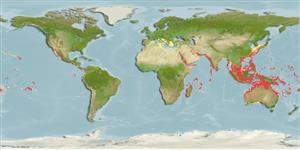Common names from other countries
Environment: milieu / climate zone / depth range / distribution range
Ecologie
Rifbewoner; diepteverspreiding 1 - 110 m (Ref. 101020). Tropical
Indo-Pacific and the Mediterranean: from East and South Africa, to western Polynesia; north to Japan and south to central Queensland and New Caledonia.
Length at first maturity / Size / Gewicht / Leeftijd
Maturity: Lm ? range ? - ? cm Max length : 4.0 cm SHL mannelijk/geslacht niet bekend; (Ref. 349); common length : 3.0 cm SHL mannelijk/geslacht niet bekend; (Ref. 349)
Sometimes found in local markets (Ref. 349). Shallow subtidal zones (Ref. 349). Most Nassariidae are omnivores and facultative scavengers (Ref. 108572).
Life cycle and mating behavior
Geslachtsrijpheid | Voortplanting | Kuitschieten | Eieren | Fecundity | Larven
This species is a non-broadcast spawner. Life cycle does not include trocophore stage. Also Ref. 833.
Poutiers, J.M. 1998. (Ref. 349)
Status op de Rode Lijst van het IUCN (Ref. 130435)
Status bij CITES (Ref. 108899)
Not Evaluated
Not Evaluated
Gebruik door de mens
| FishSource |
Tools
Meer informatie
Leeftijd/Grootte
Groei
Lengte-gewicht parameters
Lengte-lengte parameters
Morfologie
Larven
Abundantie
Internet-bronnen
Estimates based on models
Preferred temperature
(Ref.
115969): 23.6 - 29.1, mean 28 (based on 2396 cells).
Kwetsbaarheid
Low vulnerability (10 of 100).
Prijsklasse
Unknown.
